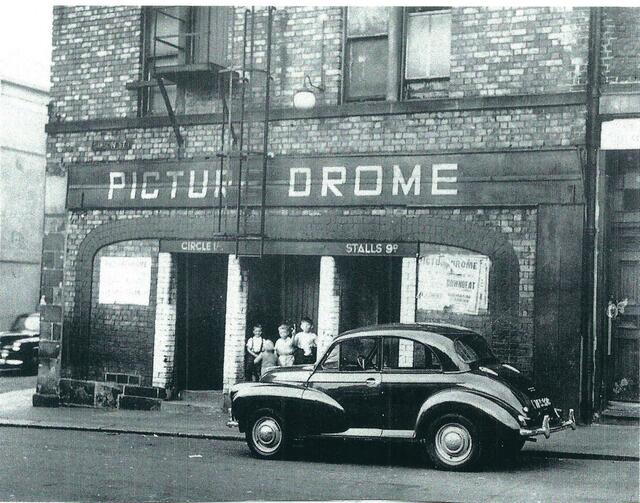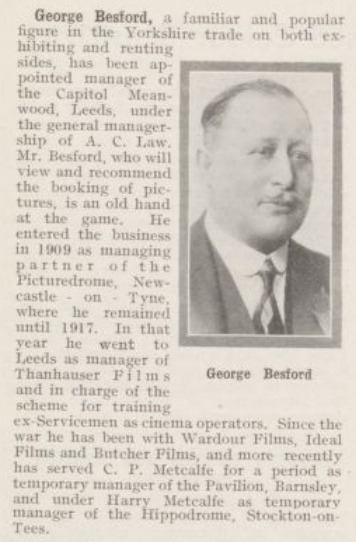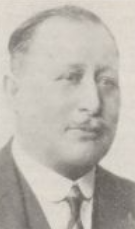George Besford was born on 15th January 1871 at Barrasford, Northumberland. He was baptised on 26th March 1871 at St. Michael and All Angels Parish Church, Warden.
George’s parents were William Besford, a farm labourer from Barrasford, and his wife Isabella Besford (née Hetherington). William and Isabella were married on 7th January (eight days before George’s birth) at St. Giles Parish Church, Chollerton. At the time of her marriage, Isabella was living with her parents Walton Hetherington and Mary Hetherington in a cottage at Walwick Grange, Warden. Her father Walton was an agricultural labourer.
The census held on 2nd April 1871 recorded George Besford at the age of 2 months. He and his mother Isabella Besford were visitors staying at the cottage occupied by her parents at Walwick Grange. Walwick Grange was the home of John Thomas Dixon, a gentleman farmer who employed 30 men and 15 women and boys. His staff included a Land Agent, Bailiff, Governess, Nurse, Dressmaker, Cook, Dairy-Maid, House-Maid, Groom, and Stable Boy. Dixon also employed 8 agricultural labourers (including George’s grandfather Walton Hetherington) and a Woodman.
The same 1871 census recorded George’s father William Besford at Barrasford. He was 28 years old and working there as an agricultural labourer. He was living with his mother Isabella Besford (unmarried and aged 52) and his grandmother, also called Isabella Besford (widowed and aged 88).
With this as the background to his entry into the world, no-one could have foreseen that George Besford would become a pioneer of cinema in Newcastle upon Tyne, not least because at this point the world’s first cinema was still more than 24 years into the future.
By the time of the 1881 census George was a 10-year-old schoolboy. He was by then living south of the Tyne at Hebburn Hall Lodge, his father William Besford being employed as a gardener at Hebburn Hall. Hebburn Hall was owned by John G. Richardson, who owned a chemical manufacturing company. George’s parents William and Isabella now had a further 3 sons, John (8), Walton (5), and William (3). Judging by the places of birth recorded on the census, the family had moved to Hebburn Hall sometime between 1878 and 1881.
Shipbuilding in Walker
The 1891 census recorded George Besford aged 20 and living at 14 Pit Street, Walker, Newcastle upon Tyne. George was a boarder with the Stephenson family and was working as a Holder Up in a shipyard. This job entailed holding rivets in place (with a long-handled curved hot anvil/hammer) while they were hammered from the other side by a Riveter. This would have been a very hard, hot, noisy and dangerous job. The piece being riveted would often be above the holder-up so he would be at risk of falling chunks of metal. On top of this, working in a shipyard would have frequently involved working at considerable heights with little or nothing to break a fall.
George Besford married Ann Scott at Byker Parish Church, Newcastle upon Tyne, on 6th September 1897. George was by then 26 and living at 4 Mosley Street, Newcastle. Ann Scott was 24, and the daughter of Michael Scott (deceased), a shipwright.
George and Ann’s first daughter, Emmeline Scott Besford was born on 9th June 1898 at 4 Hotspur Street, Heaton, Newcastle, where George and Ann were then living.
These records from 1897 and 1898 indicate that George Besford was working as a riveter.
The 1901 census recorded George, Ann and Emmeline living at 26 Jesmond Terrace, Whitley Bay. George, 30, was still working as a shipyard riveter. Ann was recorded as 28 and Emmeline as 2.
In 1908 George and Ann’s second daughter, Mary Whillance Besford was born.
It remains a mystery how and why George Besford transformed himself from a shipyard worker to a cinema manager. Suffice to say that this is nevertheless what happened!
Cinema
On 30th July 1910 the Picturedrome cinema opened in Newcastle upon Tyne. It was situated between New Bridge Street and City Road, at 36 Gibson Street (at the junction with Buxton Street). The building dated from 1878 and had been a large three-storey house with a draper’s shop on the ground floor. It was converted into a cinema with 500 seats and a raked floor. George Besford became the manager.

The 1911 census recorded George still living at 26 Jesmond Terrace, Whitley Bay. He was by now aged 40. His wife Ann was 38 and their daughters Emmeline and Mary were 13 and 3 respectively. Ann’s mother and her two sisters were living two doors away at 22 Jesmond Terrace.
George Besford seems to have rapidly taken a leading role in the wider world of cinema. The Kinematograph and Lantern Weekly of 2nd January 1913 reported that he helped to organise the North of England Kinematograph Exhibitors’ first annual trade dinner at the Hotel Metropole, Newcastle.
On 9th July 1913 the Sunderland Echo recorded that George Besford had presided at the meeting of the North Eastern Branch of the Cinematograph Exhibitors’ Association held in Sunderland the previous day.
An article in the Kinematograph and Lantern Weekly dated 16th October 1913 reported that “Mr.George Besford of the Picturedrome in Newcastle has been appointed Manager of the Queen’s, which opened a fortnight ago”. This appointment was in addition to him being manager of the Picturedrome. The Queen’s was situated on Northumberland Place, Newcastle, just off Northumberland Street.
A report in The Bioscope dated 30th October 1913 stated “A striking novelty is to be introduced shortly at the Picturedrome, Gibson Street, by the proprietor and manager, Mr. George Besford, the genial Vice-Chairman of the Northern District of the Cinematograph Exhibitors’ Association. He has booked the What Happened to Mary series of films, and he intends to show the whole twelve films in one week. The different instalments of this enthralling story will be shown in the proper sequence at each succeeding performance throughout the week, and the experiment is one which in Mr. Besford’s district, will undoubtedly meet with deserved success”. What Happened to Mary was the first serial film to be made in the United States, and was produced by Edison Studios.
All the films being shown in this era were of course silent films, with subtitles, and were generally accompanied by appropriate music provided by a pianist in the cinema itself.
George’s wife Ann sadly died of stomach cancer on 14th February 1914. She died at 22 Jesmond Terrace, Whitley Bay, the home of her mother and sisters.
George continued with his work in cinema. The Bioscope of 1st April 1915 quoted him as follows on his programme at the Picturedrome: “The Trey o’Hearts is going as well as anything I have ever had in my six years trading in this hall”. The Trey o’Hearts was an American release from 1914 and was a 15 chapter action film serial.
1917 saw major events in George Besford’s life. On 28th April of that year he married for the second time. George (then 46) married Isabel Grant (said to be 37) at Newcastle upon Tyne Register Office. Just a few weeks later, on 24th May, the Kinematograph and Lantern Weekly reported “George Besford, Film Viewer, Manager of the North of England Film Bureau, and Vice-Chairman of the Northern Exhibitors’ Union, is leaving Newcastle for Leeds to take up the management there of the Thanhauser Film Company Ltd.”
On 1st November 1917, George’s daughter Emmeline gave birth to a daughter, Irene Forster Besford. No father’s name was given.
George Besford certainly seems to have got involved with the general cinema scene in Yorkshire. The Bioscope of 8th November 1917 noted the following: “ The Leeds Committee responsible for the training of disabled soldiers in cinema work are in need of rewinders for the men to use. Anyone with ones to spare to contact George Besford of Thanhauser Films, 29 Guildford Street, Leeds, and offer a gift or loan.” The Bioscope of 25th April 1918 reported on George putting on a special cinema showing for wounded soldiers.
In July 1919 a report in the Kinematograph and Lantern Weekly recorded that George was presiding over the Leeds branch of the Imperial Film Company.
The 22nd April 1920 edition of the Bioscope reported the following: “ Mr. George Besford leaves Imperial after three years good and faithful service in most difficult and trying times. An old exhibitor in the Tyneside district himself, Mr. Besford knows just what showmen and their public want, and with the resources at his command he has these last three years done good work for his firm, with a unique record of no “let-downs” for exhibitors, with whom he was always very popular. Mr. Besford has no settled plans at the moment , but he has many friends in Yorkshire that it is hardly likely – and he certainly does not deserve it – that he will leave the territory.” George definitely found another position as a report in the Bioscope of 23rd December 1920 makes clear: “Mr. George Besford is working the West Riding – Bradford, Huddersfield and so on.” He was working for Ideal Films.
The 1921 census recorded George living at 224 Harehills Road, Leeds. He was now 50. His wife Isabel was said to be 43. George’s daughter Mary Whillance Besford, now aged 13 was living with George and Isabel, as was George’s three year old granddaughter, Irene Forster Besford. George’s elder daughter Emmeline had married Thomas Atherton in late 1920 and at the time of the 1921 census was in Leeds Maternity Hospital with their son (also Thomas Atherton).
By 1923 George Besford had changed employer again. The Bioscope of 15th March 1923 reported “Our old friend George Besford has resigned his position with Ideal Films , to take up a similar position under Bert Marshall at Wardour Films. George will be popular wherever he is”.
It seems that George was also involved with cricket. The Bioscope (25th June 1925) recorded, under the heading “Leeds v Bradford at Cricket”, “The annual cricket match between teams selected by Mr. George Besford of Leeds, and Councillor Tom Thornton of Bradford, took place on the ground of the Holbeck Cricket Club last Wednesday. For this event too, the weather was gloriously fine, and a good afternoon’s cricket was enjoyed. Mr. Besford’s XI beat Councillor Thornton’s team by 28 runs. After the match players and friends returned to the Cinema Exchange for tea, and the evening was spent at the Exchange”.
George changed employers once again in 1927. The Bioscope reported (14th July 1927) in a short article headed “Besford joins Beahan” that “L.H. Beahan of the Beahan Film Service has appointed George Besford, lately with Western Import in Leeds, as outside representative handling Argosy and other films”.
In 1930 George secured another new job. The Bioscope wrote as follows: “George Besford, a popular figure in the trade in Leeds , formerly on the renting and recently on the exhibiting side, has been appointed manager of the Hippodrome at Stockton-on-Tees. Under the supervision of Harry Metcalfe, Mr. Besford has recently been managing Mr. Metcalfe’s cinema, the Alhambra, at Barnsley, during the temporary absence, through illness, of the manager. Mr. Besford, who went to Leeds from Newcastle 15 or 16 years ago, will renew acquaintance with many old friends at Stockton.”
The era of the “Talkies” was now underway, with the first ever film featuring sound technology (The Jazz Singer) having been shown in London late in 1928. The transition was gradual and many UK cinemas were still showing silent movies in the early 1930s. George Besford would certainly have been involved in this transition.
By early 1931 George was back in Leeds managing the Capitol cinema, as the Bioscope reported on 25th March 1931:

In February 1938 George Besford was a Bradford and District delegate to the General Council of the Cinematographer Exhibitors Association (CEA).
George Besford sadly passed away at the age of 67 on 23rd May 1938 at 45 Easterly Avenue, Leeds. The next meeting of the CEA passed a resolution of condolence on George’s death, describing him as “One of the men who, 28 years ago, suggested a union of kinema owners”.
George’s widow, Isabel Besford, was still living at 45 Easterly Avenue when the 1939 Register was compiled. George’s daughter Mary Whillance Besford (now 31) was living with her. Mary was working as a school teacher. In 1968 Mary Whillance Besford, then Headmistress of Hillside County Secondary School for Girls, was awarded the OBE.
Ancestry of George Besford (1871-1938)
George’s 5x Great Grandparents were James Besford and Margaret Robson who married in 1679 at Rothbury, Northumberland.
George’s 4x Great Grandfather was George Besford (baptised 1680), the son of James and Margaret.
George’s 3x Great Grandparents were John Besford (1717-1788, the son of George Besford) and Mary Felton who were married at Birtley, Northumberland on 9th October 1740.
George’s Great-Great Grandparents were John Besford (baptised 1749, the son of John and Mary) and Margaret Forster. John Besford and Margaret Forster were married in 1768 at Birtley, Northumberland.
George’s Great-Grandparents were George Besford (the son of John and Margaret) and Isabella English, who were married at Chollerton, Northumberland on 11th April 1807.
George’s Grandmother was Isabella Besford (baptised 28th November 1819 at Birtley, Northumberland) who was the daughter of George and Isabella.
George’s father was William Besford (born 1842), the son of Isabella Besford. William’s father was not named.
